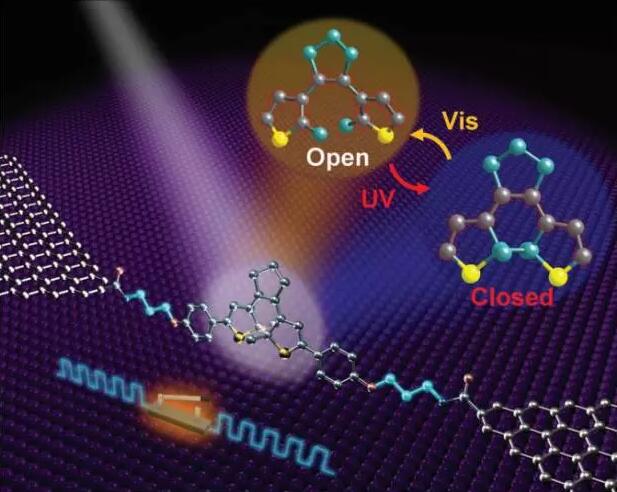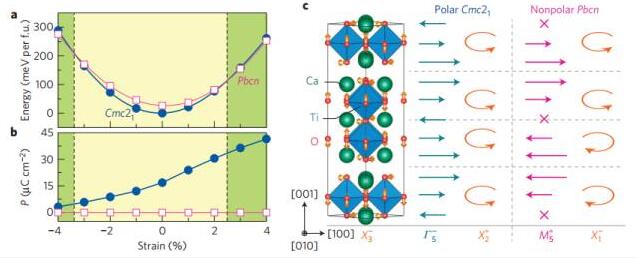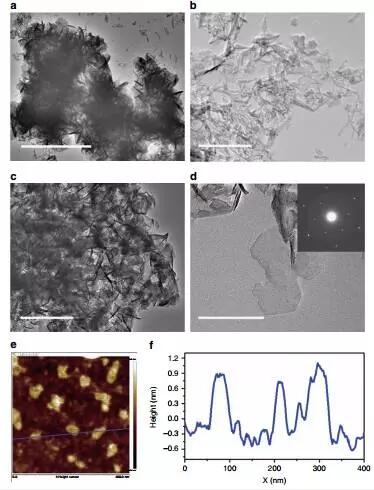Abstract 1. Organic semiconductor band structure adjustment (Bandstructureengineeringinorganicsemiconductors) A key breakthrough in modern electronics is the introduction of energy band structure engineering,...
1. Organic semiconductor band structure adjustment (Band structure engineering in organic semiconductors) 
A key breakthrough in modern electronics is the introduction of energy band structure engineering. By modulating different semiconductors to continuously adjust the bandgap and band edge energy, almost any electronic potential structure can be designed. The strong localized electronic states in organic semiconductors hinder the application of this method in these materials. Schwarze et al. show a workaround that has so far largely ignored the long-distance Coulomb interaction. It can be confirmed from the photoelectron spectroscopy that the ionization energy of the organic semiconductor crystal can be continuously adjusted over a wide range by mixing with the halogenated derivative. Accordingly, the photovoltaic band gap and open circuit voltage of an organic solar cell can be continuously adjusted by incorporating a certain proportion of donor impurities. (Science DOI: 10.1126/science.aaf0590)
2. Covalently bonded single-molecule junctions with stable and reversible photoswitching conductivity
Using molecular engineering, a single diarylethene is sandwiched between the graphene electrodes in a covalently bonded manner to form a stable molecular conduction junction. Our experimental and theoretical studies on these single-molecule junctions show and explain: reversible light-controlled conductive switches at room temperature and random switching at different temperatures according to different conductive states. Jia et al. demonstrated a dual-mode fully reversible single-molecule electrical switch with unprecedented accuracy (switching ratio of approximately 100), stability (over one year), and reproducibility (light control of 46 experimental devices) The number of switching cycles can exceed 100, and the number of random switching cycles is approximately 105 to 106). (Science DOI: 10.1126/science.aaf6298)
3. Crystal symmetry breaking and vacancies in colloidal lead chalcogenidequantum dots
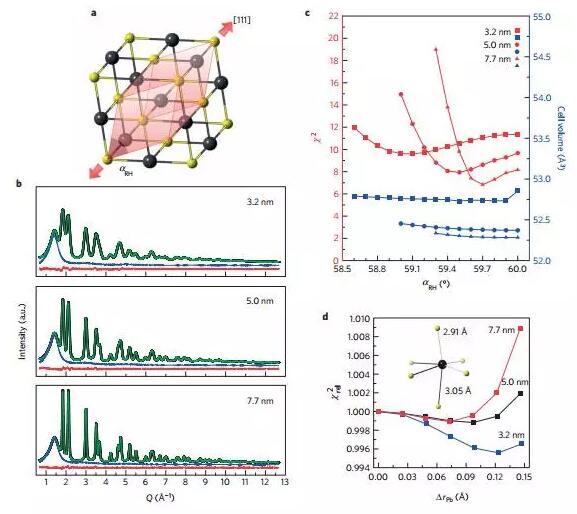
Colloidal chalcogenide lead compounds have adjustable quantum dot size and shape and low cost processing methods, making it a new class of materials for new photovoltaic, thermoelectric and optoelectronic devices. Although the atomic order and stoichiometry of the core and surface regions vary widely, the lead chalcogenide quantum dots are indeed known as rock salt type structural crystals. However, prior to this, there was no convincing proof of the effects of extremely miniaturized and surface-induced ligand effects on structural distortion. Italian science and its collaborators use cutting-edge X-ray scattering techniques and density functional theory calculations to demonstrate that PbS and PbSe quantum dots are driven by ligand-induced tensile strain at sizes below 8 nm. The displacement of the crystal lattice has undergone lattice distortion. The resulting fixed electric dipoles may have an effect on the directional attachment of these quantum dots. Evidence comes from the discovery of a central lead atom defect and the shape of a rhombohedral dodecahedron with a non-polar {110} crystal plane in a synthetic quantum dot. Once the nature of the surface ligand is changed, the difference in lattice strain is found. (Nature materials DOI:10.1038/NMAT4661)
4. Dynamical strong coupling and parametric amplification of mechanical
modes of graphene drums

Mechanical resonators are ubiquitous in modern information technology. Because they are likely to be coupled to electromagnetic and plasma states, they are promising to be a key component of future quantum information technology. Graphene-based resonators have attracted attention because of their high resonant frequency, a variety of mechanical modes, and low quality. The nonlinear coupling of the tension adjustment between the various modes of the resonator can be excited in a controlled manner. India's Deshmukh team designed a graphene resonator that is wideband at low temperatures and has a large multimode coupling strength. They observed the appearance of the new eigenmode and the amplification of the coupling mode excited by the red and blue parameters, respectively, and demonstrated that the dynamic multimode coupling is adjustable. The synergy of 60 modes is achieved under the strong coupling mechanism, and the frequency interval between the two resonance modes is about 100 MHz. The realization of the coupling between the high-frequency eigenmodes in the dynamic adjustment mechanical system opens up the possibility of quantum mechanical experiments at low temperatures. (Nature nanotechnology DOI:10.1038/NNANO.2016.94)
5. Improved chemical and electrochemical stability of perovskite oxides with less reducible cat ions at the surface
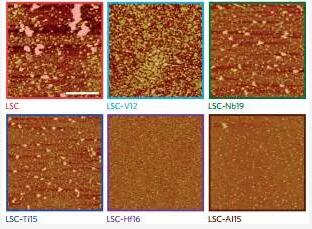
Surface separation and phase separation of perovskite-type oxides (ABO3) have a detrimental effect on the performance of energy conversion systems such as solid oxide fuel cells/electrolysis cells and the catalytic catalysis of thermochemical H2O and CO2. A key factor in the instability of perovskite-type oxides is that negative-charged A-site dopants are attracted by positively charged oxygen vacancies, causing surface separation. Although the surface oxygen vacancies that are traditionally understood are conducive to the reaction, the Yildiz team in the United States has increased the surface exchange and stability of oxygen by reducing the oxygen vacancy concentration on the surface. The "volcano" diagram shows that the optimized surface oxygen vacancy concentration coordinates the loss of oxygen exchange kinematics and chemical stability. (Nature Materials DOI: 10.1038/NMAT4659)
6. The electrical coupling between the substrate and the electronic two-dimensional MoS2 nanosheet catalytic hydrogen production process (The role of electronic coupling between substrate and 2D MoS2 nanosheetsin electrocatalytic production of hydrogen)
The excellent electrocatalytic hydrogen evolution performance on the MoS2 boundary has prompted researchers to find ways to increase the boundary concentration. The poor conductivity of the 2H basal surface results in insufficient charge transfer, which affects its electrocatalytic hydrogen evolution performance. Recently, scientists in the United States have found that the 2H basal surface of a single-layer MoS2 nanosheet can exhibit electrocatalytic hydrogen evolution performance compared with the current metal boundary and 1T phase MoS2 through the electronic coupling of the substrate to the MoS2 nanosheet. The onset potential and the Tafel slope were 0.1 V and 50 mV/dec, respectively. Effective charge injection and the presence of sulfur vacancies play a major role in improving catalytic performance. (Nature Materials DOI: 10.1038/NMAT4660)
7. Epitaxial-strain-induced polar-to-nonpolar transitions in layered oxides
Epitaxial strain in a hybrid oxide film can cause many phenomena and new functionality. The strong coupling of the strained and polarized lattices stabilizes the new ferroelectric phase or increases the polarization strength and Curie temperature. Recently, Lu and Rondinelli demonstrated the existence of a polarization-to-polar transition in the (001) film of a layered A3B2O7 hybrid ferroelectric material with biaxial strain. This transition is due to the trilinear correlation lattice mode interaction in the layered oxide. The results of this study provide a new way to look for new functionalities of layered oxides. (Nature Materials DOI:10.1038/NMAT4664)
8. Single-layer nickel-vanadium monolayer double hydroxide for efficient electrochemical water oxidation
Highly active and inexpensive water oxidizing electrocatalysts still face enormous challenges in meeting the needs of industrial production. The single-layer nickel-vanadium layered double hydroxide exhibited a current density of 27 mA cm-2 at an overpotential of 350 mV during water oxidation (57 mA cm-2 after ohmic correction). This performance is comparable to the best performing nickel-iron layered double hydroxides in the currently reported alkaline environment. The mechanism study shows that the intrinsic catalytic activity of the single-layer nickel-vanadium layered double hydroxide mainly comes from the improvement of conductivity, rapid electron transfer and abundant active sites. (Nature Communications DOI: 10.1038/ncomms11981)
This article is authorized by the new material online (micro signal: xincailiaozaixian), if other media need to reprint, please contact the new material online small series (micro signal) Gas Stove Valve
Gas Stove Valve,Adjustable Angle Valve,Stove Pulse Valve,Electronic Ignition Switch Valve,regulator valve
GUOLONG PRECISION VALVE CO.,LTD , https://www.glstovevalve.com

